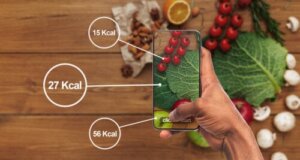How to Calculate the Calories in Food


Written and verified by the nutritionist Maria Patricia Pinero Corredor
We all need energy to perform any work; not only physical work, but also biological work. This energy is obtained through what we eat, and we measure it in calories. So, calculating the calories in food will allow us to ensure an adequate energy intake.
The calories we ingest with food are necessary for several issues:
- Physical activity
- Heartbeat
- Nervous system function
- Tissue repair
- Reproduction
Likewise, if we want to lose weight or gain weight, we need to know the different methods that allow us to calculate food calories. Read on and you will see how easy it is!
We think you may also enjoy reading this article: Check Out the Calories and Protein in Each Chicken Cut
What are calories?
A calorie is a unit of measurement of the amount of energy provided by food and certain substances. In chemistry, it’s also defined as the amount of heat required to raise the temperature of one gram of pure water to 1 degree Celsius at the pressure of 1 atmosphere.
In the field of nutrition, calories and kilocalories can be used interchangeably. However, although they’re related, in terms of energy measurement, they’re not the same thing, since 1 kilocalorie is equivalent to 1000 calories.
For example, when we say that 100 grams of cooked ham provide 213 calories, in reality, we’re talking about 213 kilocalories and 213,000 calories. But talking about calories with the corresponding mathematical units would scare anyone!
All the calories we need are found in food, and that’s why we can establish the energy or caloric value of a food. This is defined as the amount of energy produced by macronutrients when oxidized and metabolized.
Therefore, food is a potential energy reserve expressed as kilocalorie (kcal) or calorie (cal). In other international systems, kilojoule or joule measures are also used.
The energy equivalent of 1 calorie is 4.19 joules.
What are the sources of calories in food and what data do we use to calculate their contribution?
Not all food nutrients are capable of generating calories. Only the macronutrients do this: fat, protein, and carbohydrates all produce chemical energy when they’re oxidized.
Alcohol, although it’s not considered part of food, also produces energy, but without transporting nutrients. That’s why we speak of empty calories in that case.

How much does each nutrient provide?
Scientist Wilbur Atwater calculated the energy contribution of each macronutrient by measuring the increase in temperature of the water surrounding a special calorimetric pump. These values have been used to calculate the calories produced by food for more than a century.
Based on Atwater’s method, we can obtain the following:
- 1 gram of fat produces 9 kcal
- 1 gram of carbohydrate or protein yields 4 kcal
- 1 gram of alcohol or ethanol produces 7 kcal
The main caloric sources in our diets are carbohydrates and fats, since proteins should be used for other purposes and not to be oxidized as a fuel source.
In extreme cases of protein consumption for energy production, our muscle mass would be consumed, our hair and nails wouldn’t grow, and our skin would become flaccid, among other deteriorations.
How many calories do we need to consume with food?
The amount of calories we need per day is known as total energy expenditure. It represents the sum of several factors that vary from person to person:
- Resting energy expenditure: This is the major part of our daily energy expenditure, which varies between 50 to 75% of the total energy expenditure. It’s obtained from the basal energy expenditure to maintain organ functions, which depends on our age, gender, menstrual cycle, pregnancy, or lactation, among other factors.
- The thermal effect of food: This is the caloric expenditure that occurs during digestion, metabolism, and utilization of nutrients. This factor requires 5 to 10% of all daily calories.
- Physical activity: This considerably increases the caloric requirement per day. For this reason, it’s the main ally of low-calorie diets for weight loss. The expenditure ranges from 15 to 30%.
Like this article? You may also like to read: Discover How Many Calories You Should Eat Per Day
How to calculate the calories contained in food
Food manufacturers who have to report the calories present in food use the traditional calorimetric bomb method. They do this by directly assessing the heat production of a food and therefore its energy intake.
However, not all of us have calorimeters in our homes. So, we must use other indirect methods.
1. Determining total calories from Atwater’s method
Most foods are sold packaged and almost all have nutritional information on their labels. The calorie and nutrient content per serving or per 100 grams of the product is listed there.
You can check the calories on the label, and if you want to be more sure, you can apply the Atwater method rationale. To do this, you should check the amount of carbohydrates, protein, and fat in a serving or 100 grams.
For example, the whole milk powder package reports that 1o0 grams contains 25.8 grams of protein, 26.7 grams of fat and 38 grams of carbohydrates.
The step-by-step procedure would be as follows:
- Multiply each macronutrient by its caloric equivalent. The grams of protein and carbohydrate are multiplied by 4 kcal and fat by 9 kcal. For the protein of the milk powder in the example it would be 25.8 grams times 4 kcal; for fat 26.7 grams times 9 kcal and for carbohydrates 38 grams times 4 kcal.
- By multiplying, we get that 100 grams of milk provides 103 kcal from protein, 240 kcal from fat, and 152 kcal from carbohydrates.
- Now each individual count is added up. 103+240+152=495 kcal. This amount should match the caloric intake on the label.
- Take into account the serving size you’re going to use. The amount of macronutrients and calories will depend on this. For example, if instead of 100 grams of milk you need to use 120 grams, the macronutrient values will be different.
- Apply a rule of three. Knowing that 100 grams of milk contains 25.8 grams of protein, you can multiply 120 x 25.8 and then divide by 100.
- With the new macronutrient values, now find the caloric intake of the 120-gram serving you will consume.
2. Use the most popular food composition guides to calculate the calories in food
As an alternative to the information shown on the label, there are guides that document the nutritional value of the most common foods. Each country analyzes those of its own gastronomy and those most commonly used in the region.
A reliable guide, for example, is the Handbook of the Nutritional Value of Food in Common Units and the USDA’s Nutritive Values of Foods of the USDA.
In this type of guide, the serving size must be specified: ounces, grams, or cups. In addition, foods are listed in alphabetical order or grouped into sections: fruits, grains, and meats, among others.
In the case of any home preparation that doesn’t appear on the list, you must calculate the calories provided by each main and secondary ingredient, such as oil or bread crumbs, for example. With a pencil and paper, you can then apply the Atwater method.
Another detail to consider when using these guides is to select the foods that are most similar to the one you’re interested in. If it’s a chicken breast with skin or without skin, for example, its caloric value is different.
The other point to keep in mind is the variety, especially in the case of vegetables and fruits, cheeses, nuts, meats and fish. Some packaged foods also have subgroups, such as low-fat or high-fat, canned foods in oil, tomato or water, whole-grain or refined products.
When extracting information on the amount of carbohydrates, make sure to take into account the available ones. Fiber should be subtracted from the total carbohydrates, since it’s not digested and it doesn’t contribute calories.

3. Use a virtual calculator
There are virtual calorie calculators to get the nutritional information on foods. In fact, the United States Department of Agriculture provides information on more than 6000 foods. There, they record calorie, macronutrient and micronutrient intake.
On the other hand, the calculator in the WebMD calculator provides only the number of calories and serving size. There are others that provide information on fresh foods and prepared foods in restaurants.
4. Download an app to your phone
To make the process a little easier, some apps allow you to calculate the calories in food. They can even help you to count the calories of what you eat per day to know if you’re within the energy requirement you need.
Other mobile applications modify and adjust the calories according to the level of physical activity. Meanwhile, there are also those that allow you to make adjustments to increase or decrease calories and even distribute nutrients.
It’s very easy to use these applications. All you have to do is enter your age, gender, weight, height, goal, and the foods you eat during the day.
How accurate are these methods to calculate the calories in food?
Although a calorimeter gives reliable results, there are a wide variety of foods in each food group and the metabolism of each nutrient is individualized. The Atwater method doesn’t take into account the digestion and metabolism process of each nutrient. This makes calorie calculations somewhat inaccurate.
In this regard, a group of experts determined the calories provided by pistachios using a biological method of metabolizable energy through intake, absorption, and excretion. They demonstrated that these nuts offer 5% less calories than the Atwater method.
That’s why we shouldn’t base our diet and food choices only on the calories given by a calculator. Metabolic individualities will determine the net amount of calories and nutrients the body will take advantage of.
Therefore, any diet we undertake should pass through the expert hands of a nutrition professional, and they should also help us follow its evolution over time.
All cited sources were thoroughly reviewed by our team to ensure their quality, reliability, currency, and validity. The bibliography of this article was considered reliable and of academic or scientific accuracy.
- Bendavid, I., Lobo, D. N., Barazzoni, R., Cederholm, T., Coëffier, M., Van der Schueren, M., Fontaine, E., Hiesmayr, M., Laviano, A., Pichard, C., & Singer, P. (2021). The centenary of the Harris-Benedict equations: how to assess energy requirements best? Recommendations from the ESPEN expert group. Clinical Nutrition, 40(3), 690-701. https://www.clinicalnutritionjournal.com/article/S0261-5614(20)30616-6/fulltext
- Fernández, T., & Tamaro, E. (2004). Biografía de Wilbur Olin Atwater. Biografías y Vidas. La enciclopedia biográfica en línea. https://www.biografiasyvidas.com/biografia/a/atwater.htm
- Fundación Española de la Nutrición. (s. f.). Alimentos y bebidas. Consultado el 9 de mayo de 2024. https://www.fen.org.es/vida-saludable
- Larson-Meyer, D. E., Krason, R. K., Meyer, L. M. (2022). Weight gain recommendations for athletes and military personnel: a critical review of the evidence. Current Nutrition Reports, 11(2), 225-239. https://pubmed.ncbi.nlm.nih.gov/35233712/
- Leaf, A., & Antonio, J. (2017). The effects of overfeeding on body composition: the role of macronutrient composition. A narrative review. International Journal of Exercise Science, 10(8), 1275-1296.https://www.ncbi.nlm.nih.gov/pmc/articles/PMC5786199/
- Mayo Clinic. (18 de junio de 2023). Counting calories: get back to weight-loss basics. https://www.mayoclinic.org/healthy-lifestyle/weight-loss/in-depth/calories/art-20048065
- Mifflin, M. D., St. Jeor, S. T., Hill, L. A., Scott, B. J., Daugherty, S. A., & Koh, Y. O. (1990). A new predictive equation for resting energy expenditure in healthy individuals. The American Journal of Clinical Nutrition, 51(2), 421-7. https://pubmed.ncbi.nlm.nih.gov/2305711/
- Ministerio de Derechos Sociales, Consumo y Agenda 2030. Gobierno de España. (s. f.). Composición de alimentos. Consultado el 8 de mayo de 2024. https://www.aesan.gob.es/AECOSAN/web/seguridad_alimentaria/subseccion/composicion_alimentos_BD.htm
- U. S. Department of Agriculture. (s. f.). Food Data Central. Consultado el 8 de mayo de 2024. https://fdc.nal.usda.gov
This text is provided for informational purposes only and does not replace consultation with a professional. If in doubt, consult your specialist.








